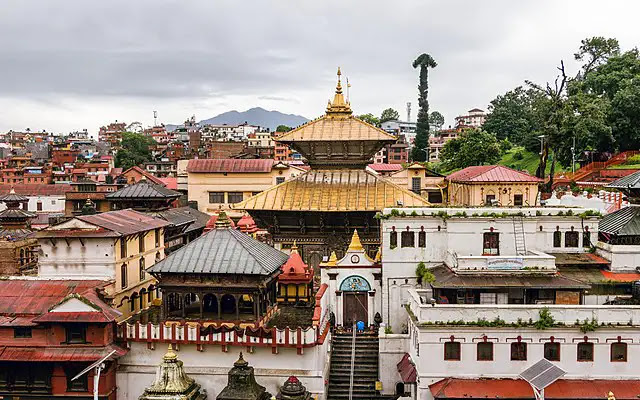Pashupatinath Temple is one of the most revered and sacred temples in the world, located in Kathmandu, Nepal. The temple is dedicated to Lord Shiva and attracts thousands of pilgrims and tourists from all over the world. With its rich history, stunning architecture, and cultural significance, the Pashupatinath Temple is a must-visit destination for anyone interested in exploring the spiritual and religious aspects of Nepal. In this article, we will explore 50 fascinating facts about this iconic temple that will leave you in awe of its beauty and significance.
50 Fascinating Facts About the Sacred Pashupatinath Temple in Kathmandu
- Pashupatinath Temple is located on the banks of the Bagmati River in Kathmandu, Nepal.
- The temple is one of the most sacred Hindu temples in the world and is dedicated to Lord Shiva.
- The temple complex covers an area of 264 hectares (652 acres).
- The main temple is a pagoda-style structure with a gilt roof and richly carved silver doors.
- The temple was first built in the 5th century AD, but the current structure dates back to the 15th century.
- The temple was renovated in the 17th century by King Bhupatindra Malla.
- The temple has been designated as a UNESCO World Heritage Site since 1979.
- The temple attracts thousands of pilgrims and tourists every year.
- The temple is considered one of the most important pilgrimage sites for Hindus.
- The temple is one of the 12 Jyotirlinga shrines of Lord Shiva.
- The temple is also the site of the famous Maha Shivaratri festival, which attracts thousands of devotees.
- The temple has four main gates: the Western Gate, Eastern Gate, Northern Gate, and Southern Gate.
- The temple is believed to be the source of the Bagmati River, which is considered holy by Hindus.
- The temple is said to have been visited by Lord Shiva himself.
- The temple has a gold-plated roof and is decorated with intricate carvings and sculptures.
- The temple complex contains several smaller shrines and temples dedicated to various Hindu deities.
- The temple complex also contains several ashrams and meditation centers.
- The temple is managed by the Pashupati Area Development Trust, which was established in 1996.
- The trust is responsible for the maintenance and preservation of the temple complex.
- The temple has undergone several renovations and restorations over the years.
- The temple is an important cultural and religious center in Nepal.
- The temple is open to visitors from 4am to 7pm every day.
- The temple complex is surrounded by a forest that is home to several species of wildlife, including monkeys and deer.
- The temple complex also contains several historic monuments, including the Bhuikhel Chaturmukha Mahadev Temple and the Jayabageshwari Temple.
- The temple complex is also home to several museums, including the Pashupati Museum and the Museum of Nepali Art.
- The temple complex contains several ghats where pilgrims can take a ritual bath in the Bagmati River.
- The temple complex also contains several meditation caves and retreat centers.
- The temple complex is surrounded by several markets and shops selling religious and spiritual items.
- The temple complex is also home to several schools and colleges.
- The temple complex is surrounded by several restaurants and cafes catering to pilgrims and tourists.
- The temple complex contains several guesthouses and hotels for visitors.
- The temple complex is an important pilgrimage site for both Hindus and Buddhists.
- The temple complex is also a popular destination for yoga and meditation practitioners.
- The temple complex is also home to several Sadhus (holy men) who live in the ashrams and meditation centers.
- The temple complex is also a popular site for film shoots and photo shoots.
- The temple complex has been featured in several Bollywood and Hollywood movies.
- The temple complex is also home to several shops selling souvenirs and handicrafts.
- The temple complex is also a center for cultural events, including traditional music and dance performances.
- The temple complex is surrounded by several parks and gardens, including the Pashupati Area Greenery Development Program.
- The temple complex has its own ambulance service and emergency response team.
- The temple complex is a popular spot for birdwatching, with over 318 species of birds recorded in the area.
- The temple complex is also a popular spot for trekking and hiking, with several trails leading to nearby hills and mountains.
- The temple complex has its own fire brigade and disaster management team.
- The temple complex is a popular spot for picnics and family outings.
- The temple complex has several designated areas for meditation and yoga practice.
- The temple complex is a hub for traditional Nepali crafts, including wood carving, stone carving, and metalwork.
- The temple complex is surrounded by several historic sites, including the Changu Narayan Temple and the Swayambhunath Stupa.
- The temple complex is a popular spot for weddings and other religious ceremonies.
- The temple complex is a symbol of Nepali culture and identity, and has been featured on several stamps and currency notes.
- The Pashupatinath Temple is an important landmark of Nepal and attracts visitors from all over the world, who come to experience its rich culture and heritage.
The Pashupatinath Temple is not just a religious site, but also a symbol of Nepal's rich cultural heritage. With its stunning architecture, scenic location, and cultural significance, the temple has been attracting visitors for centuries. The temple complex's sprawling area, which includes smaller shrines, ashrams, meditation centers, and museums, offers a unique experience that is unlike any other. Whether you are a spiritual seeker or a history buff, the Pashupatinath Temple is a destination that should not be missed. We hope these 50 fascinating facts have provided you with a deeper understanding of this incredible temple and inspire you to visit and explore it for yourself.














0 Comments